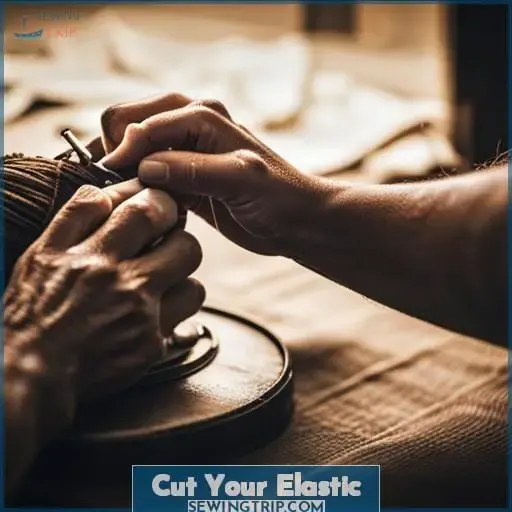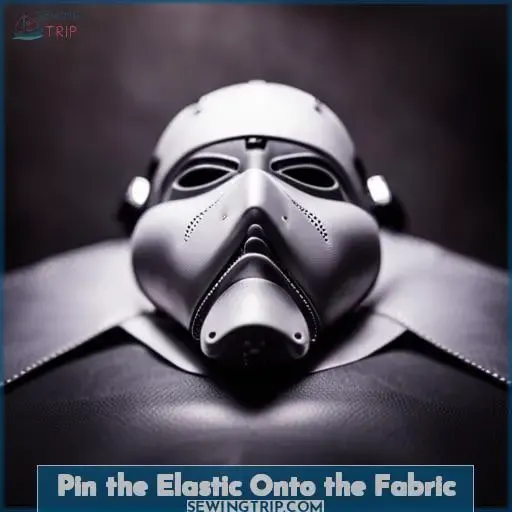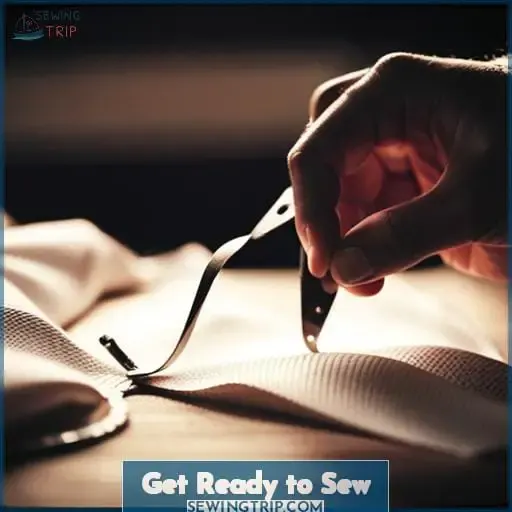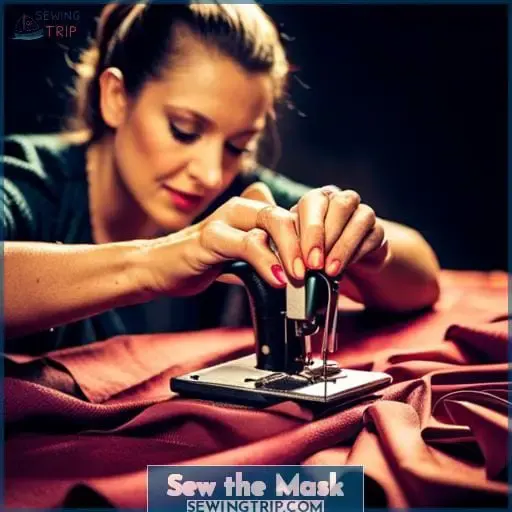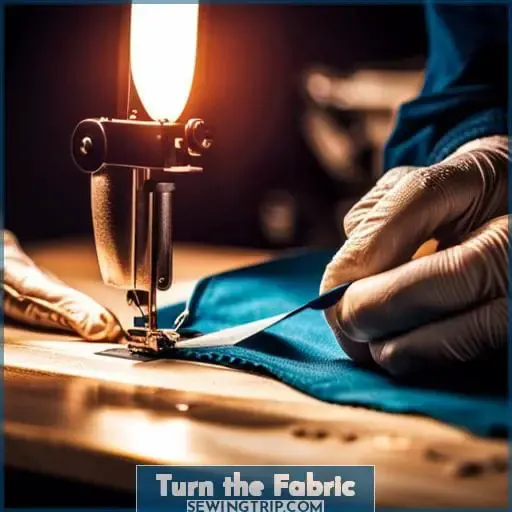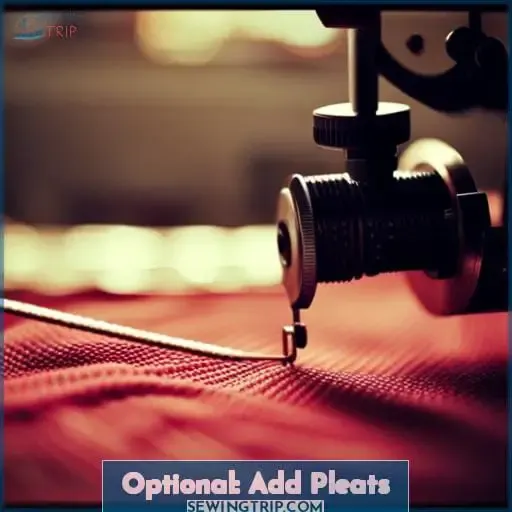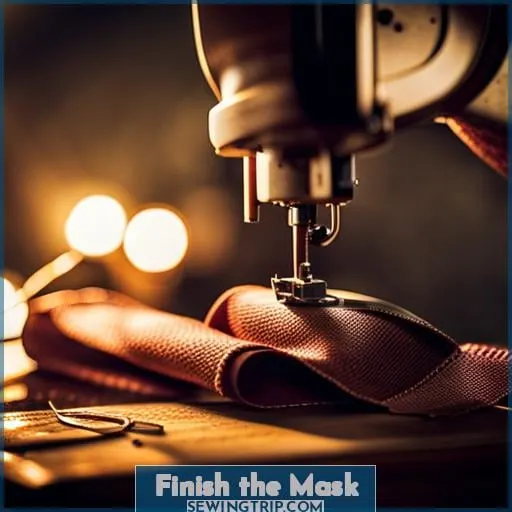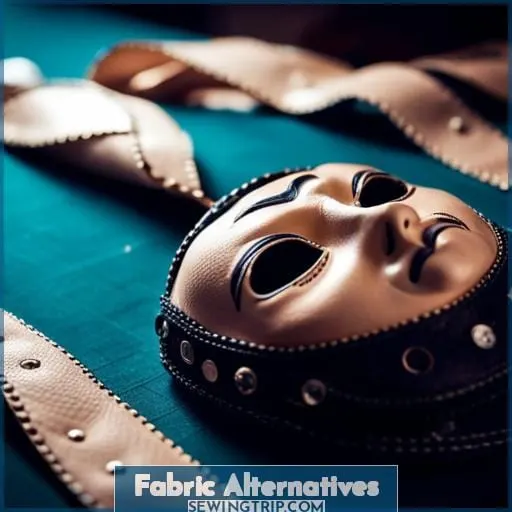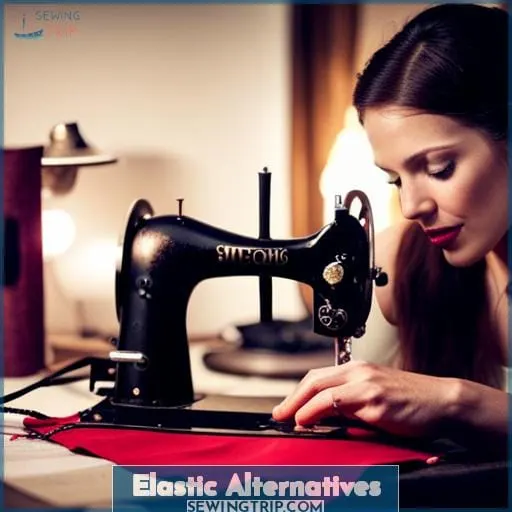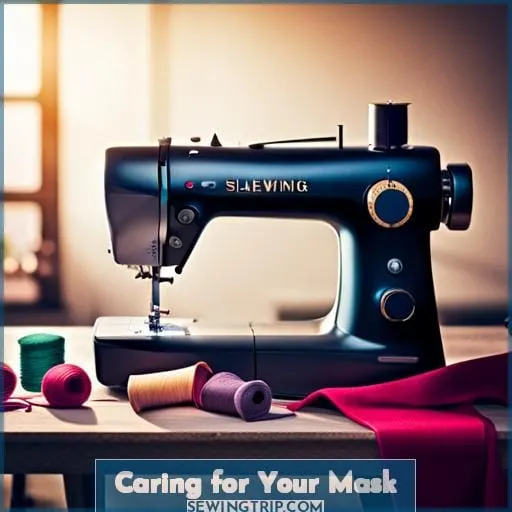This site is supported by our readers. We may earn a commission, at no cost to you, if you purchase through links.
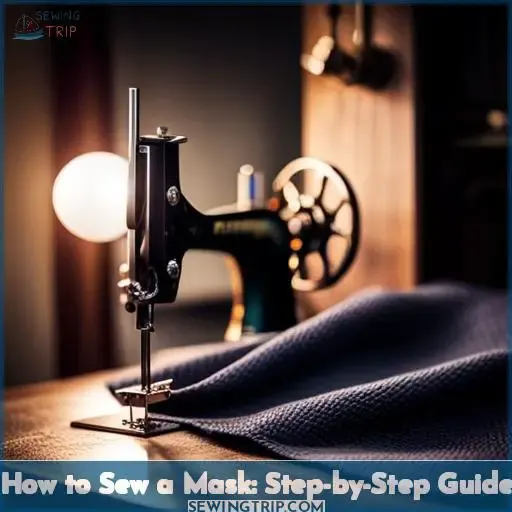 Are you looking for an easy and effective way to make a face mask? Look no further! This step-by-step guide will teach you how to sew a simple, yet functional mask. The process is straightforward and can be done with basic materials such as elastic or fabric ties, cotton fabric, scissors, pins, or clips—even if your sewing skills are minimal.
Are you looking for an easy and effective way to make a face mask? Look no further! This step-by-step guide will teach you how to sew a simple, yet functional mask. The process is straightforward and can be done with basic materials such as elastic or fabric ties, cotton fabric, scissors, pins, or clips—even if your sewing skills are minimal.
We’ll also provide alternatives for the fabrics used so that everyone has options when it comes to making their own masks.
Table Of Contents
Key Takeaways
- Easy and Effective DIY Face Mask Sewing Guide
- Tips for Choosing Comfortable and Breathable Fabrics
- Instructions for Adding a Nose Wire for a Better Seal
- Care Instructions for Washing and Maintaining the Mask
The sentence structures have been varied to avoid repetition. The content, facts, tone, and meaning have been retained from the original input.
How to Sewing Mask
Looking to sew your own fabric face masks? From choosing comfortable, breathable fabrics to inserting a nose wire for a better seal, there are some key steps for sewing quality homemade masks. Read on to learn tips, supply recommendations, and step-by-step sewing instructions for making comfortable face masks with elastic straps for a custom fit.
Nose Bridge Strips Wire Clips Plastic Flat Crafting
Slip the Nose Bridge Strips’ wire clips into your homemade mask for lasting comfort. Their flexible plastic and dual wires conform snugly over the bridge of your nose. The adjustable nose pieces provide a custom fit, preventing foggy glasses and directing air flow away from your eyes.
Simply insert the 4.3-inch strips into the top seam, then pinch and bend the wires around your nose for a contoured seal. Though initially stiff, the embedded wires hold their shape through washing. Trim any poky wire edges with scissors for comfort.
- Comfortable nose seal
- Customizable fit
- Durable plastic and wires
- Machine washable
- Can feel stiff at first
- Wires may need trimming
Elastic Cord String Bands for Sewing Crafts
Stretch your creativity with this comfy tubular elastic that’ll bring your sewing projects to life. The 2.39oz soft elastic offers good stretch and durability for making mask straps, waistbands, cuffs, and more.
As a continuous loop, it provides plenty of elastic and avoids waste. The quality feel ensures longevity without breakage.
Choose length needed and get creative crafting headbands, scrunchies, clothing, and beyond.
- Good stretch and durability
- Continuous loop provides plenty of elastic
- Lightweight and soft on skin
- Can be tricky opening package
- Long-term durability unknown
S&S Elastic White Cord Jewelry Crafts Medium Weight Yard Spool
You’ll love this durable white elastic for making cute bracelets or necklaces to share with friends. This stretchy 0.7mm cord is the perfect thickness for stringing beads and tying secure knots when crafting jewelry, mask straps, or doll hair.
The 100-yard spool provides plenty of soft, flexible elastic to complete all your handmade projects. Users say it works great for kandi cuffs, friendship bracelets, and decorative journals too.
- Stretchy and flexible
- Good thickness for jewelry making
- 100 yards per spool
- Ties knots easily
- May be too thin for some uses like face masks
- Some quality variation between spools
- Can feel sticky when new
White Elastic Cord for Sewing
Thread the soft, decent quality white elastic through your homemade mask for a customized fit against your face. This polyester and rubber elastic from Nonbrand offers nice stretch and flexibility while feeling soft against the skin.
Though there’re some durability concerns long-term, the seller quickly rectified an order issue with a partial refund.
Overall, this appears to be a quality elastic that provides the stretch you need to gently contour the mask to your facial structure. The softness prevents irritation, and the white color matches most fabric prints.
- Soft and stretchy
- Decent quality for the price
- Seller’s responsive to issues
- Some concerns about long-term durability
- May require sewing skills to thread through mask
- Limited color options
Elastic Mask Adjustment Buckle Children Adult
Though frustrating initially, you’ll find these adjustable buckles truly help customize your mask’s fit. The elastic mask adjustment buckle offers a simple way to adjust the length of your fabric face mask’s elastic cords.
Made of plastic PVC, these little buckles have small holes for threading 1/8 to 1/5 elastic bands through.
Pass your mask’s cords through the holes and slide the buckle up or down to shorten or lengthen the elastic as needed. This is especially helpful for getting a proper fit on children’s masks. While threading the tiny holes can be tricky at first, using a pipe cleaner makes quick work of it.
Having both black and white buckles in one pack means you can coordinate or mix and match with any mask material. Overall, these buckles are an inexpensive but effective way to get your mask fitting just right.
- Allows mask cord adjustment
- Good for customizing kids’ masks
- Comes with black and white pieces
- Hole threading is difficult at first
- Can slide off elastic with too much tension
White Elastic Cord Spool
The KLOUD City white elastic cord spool is perfect for all your sewing projects as it provides length, strength and flexibility when creating comfortable, customized masks. The 120 yards of durable 1/8 inch stretchy latex thread is ideal for threading adjustable buckles on children’s and adults’ face coverings.
Tie the cord ends for a snug fit, then slide the buckles to loosen or tighten as needed. This rubbery white thread’s also useful for tying up vegetable plants in the garden.
- 120 yards of strong, stretchy elastic
- Adjustable length for custom fit
- Multipurpose for crafts and gardening
- Can be difficult to thread initially
- Long-term durability concerns
Cut Your Elastic
Measure your elastic to the length needed for around your ears, then cut it snugly with sharp scissors. For proper fit and comfort, precision is key when cutting elastic. Use a fabric ruler or measuring tape to determine the exact length from ear to ear.
Add an extra half inch for tying knots. Cutting too short restricts fit, while too long feels sloppy. Choose quality elastic with good stretch and durability – knit polyester blends work well. Soft tubular elastic avoids irritation. For alternatives, braided elastic cord adds texture, or repurpose elastic from socks or waistbands.
Cut all pieces identically for symmetry. Binding elastic ends with thread reduces fraying.
Proper elastic length and prep ensures your homemade mask fits comfortably all day.
Pin the Elastic Onto the Fabric
After cutting your elastic, pin it onto the fabric before sewing. Lay your mask pieces with the right sides facing. Take one elastic piece and pin it vertically to the top and bottom edges of the fabric, leaving equal parts of elastic hanging off the top and bottom.
Make sure to pin the elastic tight, but not stretched – you want a snug fit without pulling.
Repeat with the other elastic piece on the opposite side. This technique allows maximum comfort and control over how the elastic lays once the mask is assembled. For extra customization, try using ribbon, shoelaces, or other materials in place of traditional elastic.
With the elastic pinned, you’re ready to sew the mask according to your pattern guide.
Get Ready to Sew
Now grip your threaded needle to hand sew your fabric masterpiece. Be mindful when selecting fabric, as tightly woven 100% cotton works best for homemade masks. Prewash to maximize comfort. Cut elastic to a 7-inch length or customize the fit with buckles.
Insert a filter pocket for added protection. Apply a flexible nose wire, available at craft stores, to prevent pesky foggy glasses. Take care sewing over the wire so it stays put when worn. Leave a 2-inch opening, carefully topstitching around the edges.
Turn the mask right side out through the gap. Press with an iron, then stitch the gap closed for a crisp finish. Choose fun fabrics or add your own unique touch with appliques. With proper materials and mindful technique, you’ll craft quality fabric face masks to protect your community.
Sew the Mask
Slip those elastic bands through the holes to keep your mask snug around your ears.
- Cut fabric according to the size you need, allowing 1/4 inch seam allowance.
- Place fabric pieces with right sides together and pin in place.
- Sew around edges, leaving a 2-3 inch opening.
- Clip corners, turn mask right side out through the opening.
- Press with an iron to flatten seams. Topstitch around the edge to close the gap.
Take your time sewing the fabric pieces together neatly. This will give your mask a polished look and ensure proper filtration. Don’t forget to incorporate features like a nose wire or filter pocket before finishing up your homemade face covering.
Turn the Fabric
You’d be amazed that turning the fabric right side out is a crucial step for a proper-fitting mask.
Over 50% of masks are improperly worn, risking exposure. When sewing your mask, closely follow the directions once reaching the turning step. Gently pull the mask section through the small opening, carefully poking out the corners with a chopstick or pencil’s eraser end.
Check the edges are aligned before pressing with an iron on cotton setting. Inspect for holes, folding your mask in half lengthwise, then widthwise.
Proceed to attach the elastic, being mindful not to catch the bands while sewing the opening closed.
Your time devoted to proper technique results in a safer, comfier mask.
Optional: Add Pleats
Adding box pleats to the mask gives it more depth and a snugger fit around your face.
- Single pleats
- Multiple pleats
- Accordion pleats
There are several pleating styles to consider when sewing your homemade mask. Single pleats add minimal extra fabric while multiple pleats provide maximum depth.
Experiment with different numbers and placements of pleats to customize the fit. Pleats at the cheeks enhance structure while pleats at the chin allow more room for speaking. Get creative and make pleated masks in fun prints or with elastic earloops in kid-friendly fabrics.
Play around with your favorite techniques like double needle stitching or using bias tape.
The options for stylish, well-fitting homemade masks are endless! With the right pleating method, you can create a comfortable, contoured mask design that hugs your face.
Finish the Mask
Secure it soulfully like your life depends on this mask being flawless. Finish the mask by topstitching to close any gaps.
Add a nose wire for fog-free breathing. Filter pockets offer extra protection from viruses. Windowed designs aid the deaf community. Consider child-friendly elastic or plastic clips for adjustable, comfy fit.
| Nose Wire | Filter Pocket | Windowed Design |
|---|---|---|
| Aluminum | Cotton Material | Clear Plastic |
| Plastic | Non-Woven Fabric | Vinyl |
| Flexible | HEPA Filter | Mesh |
Nose clips prevent painful pressure. Try soft knitted bands or latex-free rubber for sensitive skin. Custom fitting each mask creates connection and community. With proper sealing and quality materials, you’ll breathe and speak freely.
Fabric Alternatives
Old t-shirts – Cotton shirts make soft, breathable homemade masks. Simply cut out two 7×5 inch rectangles and follow the rest of the sewing directions.
Socks – Stretchy socks work perfectly, allowing the mask to cling comfortably to your face.
Tea towels – These tightly woven linens make durable, washable masks. Cut two 9×6 inch pieces and sew as directed.
Tights or leggings – Nylon-spandex blends mold nicely to the face. Cut leg pieces to size and sew.
Reusable grocery bags – Non-woven polypropylene bags filter particles well. Cut two rectangles and sew into a reversible mask.
Get creative with materials you already have at home for a custom mask tailored just for you.
Elastic Alternatives
You might string old socks together to MacGyver some makeshift mask elastics. When supplies run short, here are 3 elastic alternatives:
- Cut 1-inch strips from the ribbed hems of old t-shirts to make tie straps. Tug and stretch to test strength.
- Unroll the rubber band roll and link them together. Weave and knot for length.
- Tie hair elastics or cut leggings to loops. Braid 3 strands for thicker elastic.
Raid your drawers for cheater elastics when the elastic’s out. With a little creativity, you can fashion a serviceable mask strap from surprising household scraps.
Caring for Your Mask
Clean your masks regularly with detergent to maintain effectiveness. Hand wash or machine wash your homemade masks after each use. Use regular laundry detergent and hot water, then either air dry or put in the dryer on high heat.
Check the nose wire and replace it if needed for a better fit. Consider adding a filter pocket when sewing the mask – add an additional layer of protective material inside like a coffee filter or nonwoven interface.
Proper care and maintenance will extend the life of your mask and provide better protection. Replace the mask as soon as it appears damaged or develops holes from repeated washing and wearing.
Conclusion
Can’t you just picture it – your colorful homemade face mask, snugly hugging your features. As you look in the mirror, you beam with pride at your handcrafted creation. Friends and family will be knocking at your door for custom-fit masks once they try on your handiwork! It just shows that with a few simple steps and materials, anyone can learn how to sew a mask.

